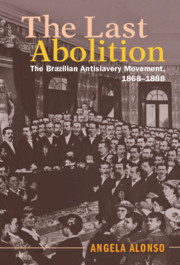Book contents
- The Last Abolition
- Afro-Latin America
- The Last Abolition
- Copyright page
- Dedication
- Contents
- Figures
- Maps
- Tables
- Acknowledgments
- Abbreviations
- Introduction
- 1 Elite Abolitionism
- 2 Pro-Slavery Rhetoric
- 3 The Moral Repertoire of Abolitionism
- 4 The Theatricalization of Politics
- 5 Expansion
- 6 Results-Based Abolitionism
- 7 Votes: A Movement/Government Alliance
- 8 Bullets: Movement and Countermovement
- 9 The March to Victory
- 10 Future of the Preterite
- 11 Abolitionism as a Social Movement
- Annex
- Bibliography
- Index
8 - Bullets: Movement and Countermovement
Published online by Cambridge University Press: 24 September 2021
- The Last Abolition
- Afro-Latin America
- The Last Abolition
- Copyright page
- Dedication
- Contents
- Figures
- Maps
- Tables
- Acknowledgments
- Abbreviations
- Introduction
- 1 Elite Abolitionism
- 2 Pro-Slavery Rhetoric
- 3 The Moral Repertoire of Abolitionism
- 4 The Theatricalization of Politics
- 5 Expansion
- 6 Results-Based Abolitionism
- 7 Votes: A Movement/Government Alliance
- 8 Bullets: Movement and Countermovement
- 9 The March to Victory
- 10 Future of the Preterite
- 11 Abolitionism as a Social Movement
- Annex
- Bibliography
- Index
Summary
In 1885, the Conservative Party/pro-slavery countermovement took power and closed the institutional agenda to abolition. Besides, the government started to repress abolitionist acts in the public space. The new Prime Minister, the Baron of Cotegipe, rolled out a repressive program, using legal measures, and allowed the pro-slavery countermovement to relying on extra-legal methods. The harassing, persecuting, and arresting of abolitionists increased. The movement then shifted from public demonstrations to civil disobedience, and clandestine activities. Based on the North-American underground railway strategy, abolitionists set up assisted collective runaway routes to get slaves to “free soil”. Abolitionists also declared in their newspapers their willingness to take up arms to defend their activists and liberate slaves. This radicalization made it impracticable to maintain slavery without the use of force. This was a phase of confrontation since the government counted on military repression and the pro-slavery countermovement´s militias to face the abolitionists' strategy.
Keywords
- Type
- Chapter
- Information
- The Last AbolitionThe Brazilian Antislavery Movement, 1868–1888, pp. 271 - 318Publisher: Cambridge University PressPrint publication year: 2021



